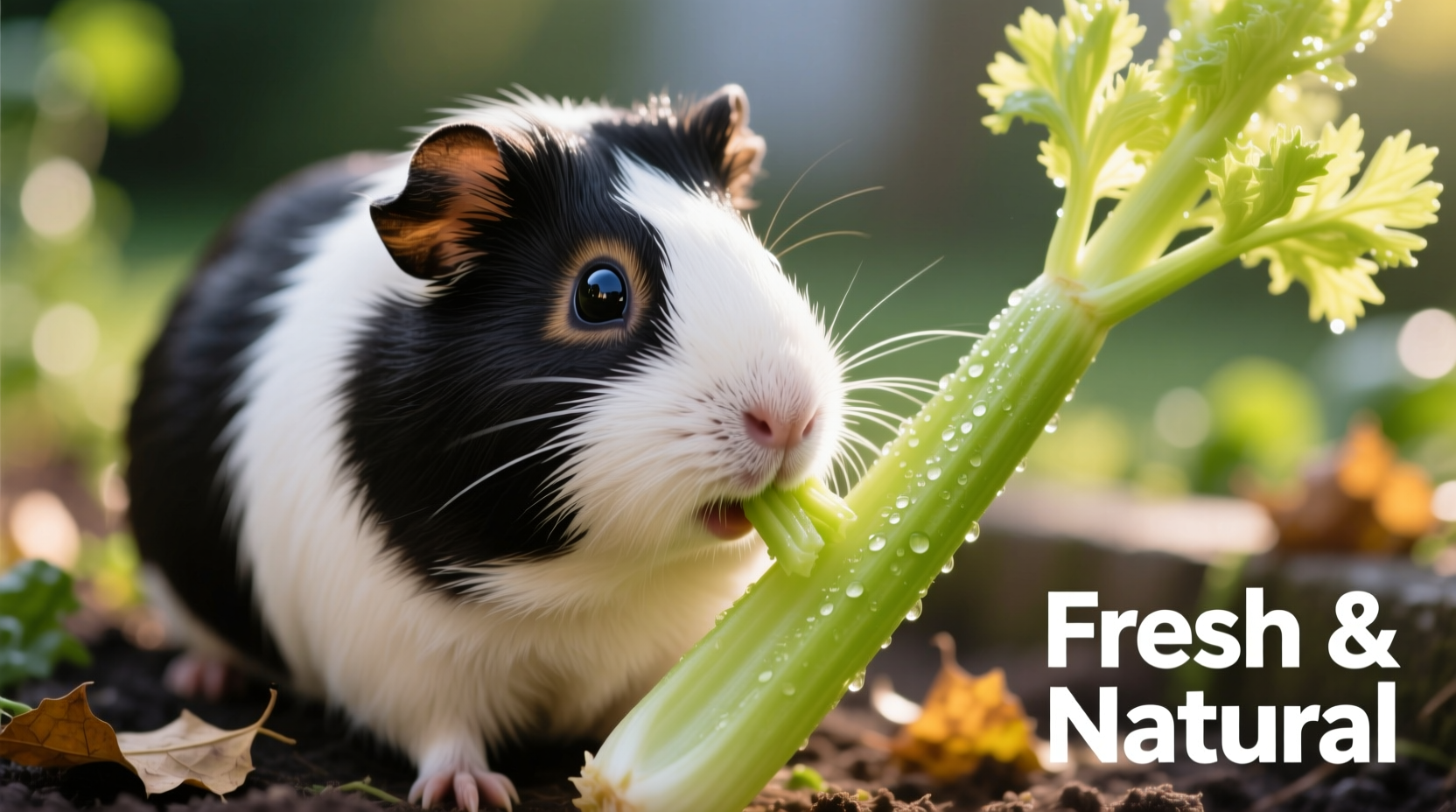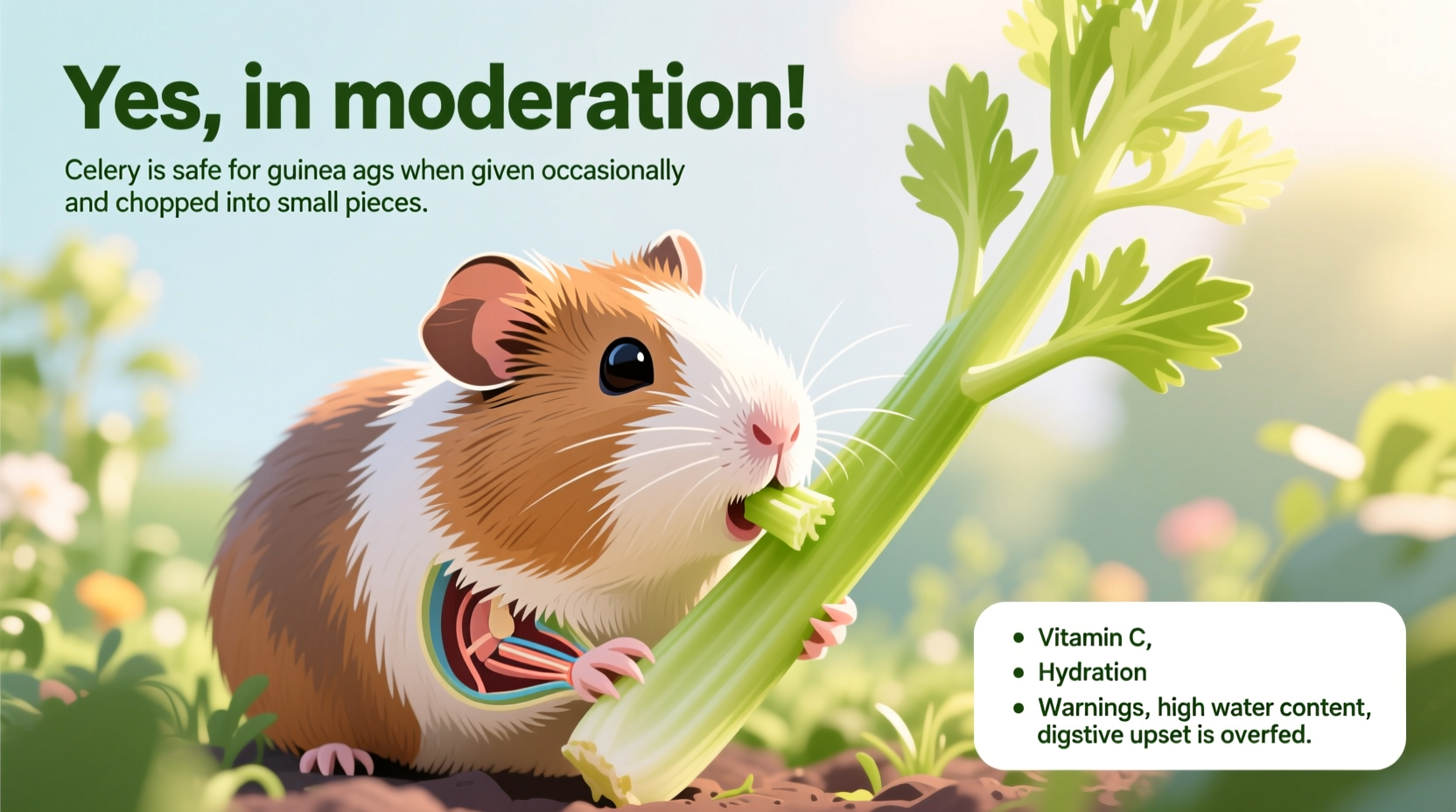Yes, guinea pigs can safely eat celery in moderation. This crunchy vegetable provides essential vitamin C and hydration but should be limited to 1-2 small stalks once or twice weekly due to its high water content and oxalates. Always wash thoroughly and remove strings to prevent choking hazards.
Why Celery Matters in Your Guinea Pig's Diet
As a responsible guinea pig owner, you're probably constantly researching what foods are safe for your furry companion. Guinea pigs require vitamin C in their diet since they can't produce it themselves, making vegetable selection critical for their health. Celery often appears on pet forums as a potential snack, but understanding exactly how and when to feed it can prevent potential health issues while maximizing nutritional benefits.
Nutritional Profile: What Celery Offers Your Guinea Pig
Celery contains valuable nutrients that support guinea pig health, but it's important to understand both the benefits and limitations. Unlike many vegetables, celery provides hydration along with essential vitamins, making it particularly useful during warmer months.
| Nutrient | Amount per 100g Celery | Benefit for Guinea Pigs |
|---|---|---|
| Vitamin C | 3.1mg | Prevents scurvy, supports immune function |
| Water Content | 95% | Hydration support, especially in warm weather |
| Dietary Fiber | 1.6g | Promotes healthy digestion |
| Calcium | 40mg | Necessary but requires moderation to prevent bladder stones |
| Oxalates | Moderate | Can contribute to bladder stones if consumed excessively |
This nutritional comparison shows why celery should be considered a supplemental treat rather than a dietary staple. According to the Veterinary Partner, a resource maintained by the American Animal Hospital Association, guinea pigs require 10-50mg of vitamin C daily, but their calcium needs must be carefully balanced to prevent urinary issues.
Safe Preparation: Turning Celery Into a Healthy Treat
How you prepare celery matters as much as how much you feed. Follow these veterinarian-recommended steps to ensure safety:
- Thorough washing - Remove pesticides and contaminants by soaking in cold water for 2 minutes
- String removal - Use a vegetable peeler to eliminate fibrous strings that could cause choking
- Proper cutting - Slice into 1-inch pieces for easier handling and consumption
- Portion control - Limit to 1-2 small stalks per feeding session
Interestingly, celery leaves actually contain higher concentrations of vitamin C than the stalks while having lower oxalate levels. The Merck Veterinary Manual notes that many guinea pig owners unknowingly discard the most nutritionally valuable part of the celery plant. Including a few washed leaves with the stalks can boost nutritional value without increasing health risks.

When to Avoid Celery: Important Health Considerations
Celery isn't appropriate for all guinea pigs in all circumstances. Understanding these context boundaries will help you make informed decisions:
- Bladder stone history - If your guinea pig has had urinary issues, eliminate high-calcium vegetables including celery
- Introduction to new foods - Always introduce celery gradually over 7-10 days to monitor for digestive upset
- Age considerations - Baby guinea pigs under 6 months need different nutritional balances
- Medication interactions - Consult your vet if your guinea pig is on medication that could interact with celery
The American Society for the Prevention of Cruelty to Animals (ASPCA) reports that improper vegetable selection accounts for approximately 23% of preventable guinea pig health issues. While celery itself isn't dangerous, improper feeding practices can lead to problems. A 2022 study published in the Journal of Exotic Pet Medicine found that guinea pigs fed excessive high-water-content vegetables like celery showed increased incidence of loose stools and digestive discomfort.
Creating a Balanced Vegetable Rotation
Celery should be just one component of a diverse vegetable diet. Here's how to incorporate it effectively:
- Rotate celery with other vitamin C-rich vegetables like bell peppers and parsley
- Pair celery with low-calcium vegetables such as cucumber or zucchini
- Limit celery to 1-2 times weekly, never consecutive days
- Always provide unlimited timothy hay as the dietary foundation
According to the Guinea Pig Manual by Peter Gurney, a respected authority on small pet care, "Variety isn't just the spice of life for guinea pigs—it's essential for their nutritional wellbeing." This principle applies directly to celery consumption; while it offers benefits, it shouldn't dominate your pet's vegetable intake.
Monitoring Your Guinea Pig's Response
After introducing celery, watch for these signs that indicate proper tolerance:
- Normal, firm droppings within 24 hours
- Continued interest in regular hay consumption
- No changes in urination patterns
- Maintained energy levels and activity
If you notice soft stools, decreased appetite, or unusual lethargy, discontinue celery immediately and consult your exotic veterinarian. These symptoms typically resolve within 24-48 hours after removing the problematic food.
Frequently Asked Questions
How often can I feed celery to my guinea pig?
Limit celery to 1-2 small stalks once or twice weekly. Overfeeding can cause digestive upset due to its high water content and may contribute to bladder stone formation from oxalates. Always rotate with other vegetables for dietary variety.
Are celery leaves safe for guinea pigs?
Yes, celery leaves are actually safer and more nutritious than the stalks. They contain higher vitamin C and lower oxalate levels. Wash leaves thoroughly and offer a small handful 1-2 times weekly as part of a varied diet.
Can celery cause bladder stones in guinea pigs?
Celery contains moderate oxalates which can contribute to bladder stone formation when fed excessively. For healthy guinea pigs, moderate portions (1-2 stalks weekly) are generally safe. However, guinea pigs with history of urinary issues should avoid celery completely as recommended by veterinary nutritionists.
Should I remove strings from celery before feeding?
Yes, always remove the fibrous strings using a vegetable peeler. These strings pose a choking hazard and can cause digestive blockages in guinea pigs. Proper preparation includes washing thoroughly, removing strings, and cutting into 1-inch pieces for safe consumption.











 浙公网安备
33010002000092号
浙公网安备
33010002000092号 浙B2-20120091-4
浙B2-20120091-4